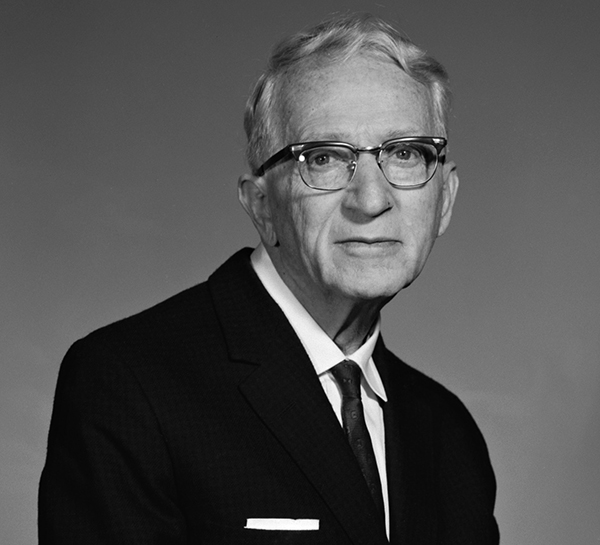
Mark Marshall, 1966. Photo: Medical photography, University of Alberta Hospital
The University of Alberta's Department of Ophthalmology is celebrating its 80th anniversary in 2017. Part of the department's rich history includes ophthalmologist and former department head Mark Marshall and his role in creating what is informally known as the "Marshall Plan." Established in 1946, the same year he became the director of graduate medical education, Marshall's plan laid the foundation for the U of A's medical residency program.
The Marshall Plan was established to assist Second World War veterans in establishing their careers. At the start of the war, the U of A offered an accelerated medical program that allowed individuals to enter into military service immediately after completing a short internship. Following the war, many of these veterans were interested in specialty training. JJ Ower, dean of the medical school, and John Scott, then-head of the Department of Medicine, tasked Marshall, a First World War veteran, with exploring the possibility of creating a postgraduate training program that met Royal College of Physicians and Surgeons of Canada standards. This program became the Marshall Plan.
By 1949, the Royal College approved postgraduate training in ophthalmology, anesthesia, urology and other several other specialties and subspecialties at the U of A.
Anesthesiologist Ted Gain reflected on his experiences with the Marshall Plan in an interview with Tony Cashman. He remembered:
I got my MD in January 1943, the first army speed-up class. We were allowed nine months internship and then into the service. When I came back, Dr. Marshall pushed me into the postgraduate program. I guessed he pushed all of us. He took it on single-handedly. You could call him the father of postgraduate training. The idea was the development of basic and clinical research in each of the specialities and subspecialities. It was all done within the hospital. Except for orthopaedics and ophthalmology…[individuals in these specialties] were encouraged to go away for one year. It was designed primarily to bring people back with expertise in some area and form a cadre of teachers.
Those who completed the Marshall Plan then took their Royal College examinations. According to Gain, prior to the Marshall Plan, the U of A had issued specialist certifications themselves, which were only applicable in Alberta.
In another interview with Cashman, plastic surgeon Mac Alton reflected on Marshall's support for postgraduate training, stating:
I was on the Marshall plan. At one point I was applying to Duke University. I met Dr. Marshall in the corridor and he said: 'Let's talk a minute.' Right there we spent a couple of hours writing my letter to Duke. We happened to be in Montreal when the results of my fellowship exams were announced. There was myself and another man from Edmonton who'd passed... Dr. Marshall threw a party for us all in the Maritime Room of the Ritz-Carlton Hotel.
Like Gain and Alton, the majority of postgraduate trainees in the first decade of the program were U of A MD graduates. As historian Elise Corbet explains, applicants to Marshall's program were required to have graduated from an approved medical school, and completed a year internship in an approved hospital. The postgraduate program itself included a year in the basic sciences, and three additional years in the chosen speciality as a senior intern, then an assistant resident, and finally a resident. Trainees typically completed two to three years in Edmonton and then moved elsewhere for their final year. Corbet notes that by 1954, 23 residents had completed their training, of whom 17 were practising in Alberta and 12 employed by the U of A medical school.
Marshall as a controversial figure
Besides establishing and developing the Marshall Plan-which he administered until his retirement in 1961-Marshall is also remembered by his former colleagues for the many controversies he created during his time at the U of A. Notably, Marshall built an office on University of Alberta Hospital (UAH) grounds without the permission or knowledge of either the dean of medicine, or the U of A president. The office was built as an annex to the Mewburn Pavilion, which was constructed in 1945 as a veteran's hospital. According to Corbet and those interviewed by Cashman, Marshall arranged the construction of the building in consultation with the provincial government and paid for it by himself.
Don Wilson, former head of the Department of Medicine stated, "He got to [Premier] Manning and got a grant of space on hospital grounds to build his own private office...The medical advisory board were up in arms. We all stormed in to see Angus [McGugan, superintendent of the UAH], about this flagrant misuse of government land. How could one person do this? Mark claimed it was going to be used for teaching."

Aerial photograph from 1960 in which Marshall's building is visible. Photo: Medical photography, University of Alberta Hospital.
Alton recalled, "There are lots of stories about that building that appeared on the north end of the hospital property. I'm sure the board knew nothing about it."
The building remained on the hospital grounds until the Mewburn Pavilion was torn down.
For additional information on Mark Marshall see Elise A. Corbet's Frontiers of Medicine, which is available at the University of Alberta libraries, and Ophthalmology at the University of Alberta, a recent open-access article published by members of the Department of Ophthalmology and visual sciences at the U of A and historian Judith Friedman.
Watch the inaugural Mark Marshall lecture below: